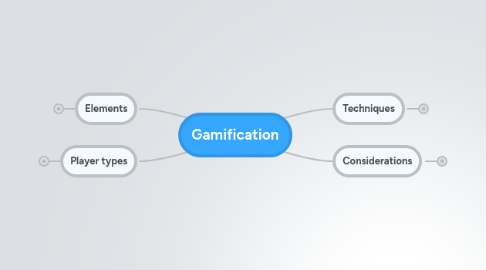
1. Techniques
1.1. Rules
1.2. Constant feedback
1.3. Chance / luck / unpredictable
1.4. Gathering resources
1.5. Monitoring
1.6. Equal chances for participants
2. Elements
2.1. Intrinsic value
2.1.1. Autonomy
2.1.2. Mastery
2.1.3. Power
2.1.4. Meaning
2.1.5. Belonging
2.1.6. Learning
2.1.7. Fun
2.1.8. Love
2.1.9. Satisfaction
2.2. External elements
2.2.1. Avatars
2.2.2. Teams
2.2.3. Objectives
2.2.4. Dynamics
2.2.4.1. Time-based patterns & systems
2.2.4.2. Pacing
2.2.4.3. Progressive unlocks
2.2.4.4. Appointments
2.2.4.5. Reward schedules
2.2.4.5.1. Habits
2.2.4.5.2. Surprise
2.2.4.5.3. Addiction
2.2.4.6. Dynamic schedules
2.2.5. Mechanics
2.2.5.1. Systems & features that make progress visible
2.2.5.2. Points
2.2.5.2.1. Points track & measure progress
2.2.5.3. Levels
2.2.5.3.1. Give pacing, unlocks, status
2.2.5.4. Leaderboards
2.2.5.4.1. Showcase active, engaged players
2.2.5.5. Badges
2.2.5.5.1. Goals
2.2.5.5.2. Progress
2.2.5.5.3. Collecting
2.2.5.6. Collections
2.2.5.6.1. Goals
2.2.5.6.2. Completion
2.2.5.6.3. Surprise
2.2.5.7. Journey
2.2.5.7.1. Lifecycle + progression
2.2.5.8. Virtual currency
2.2.5.9. Challenges / missions
2.2.5.10. Competition
2.2.5.10.1. Bragging
2.2.5.10.2. Taunting
2.2.5.10.3. Challenging
2.2.5.11. Collaboration
2.2.5.11.1. Sharing
2.2.5.11.2. Helping
2.2.5.11.3. Gifting
2.2.5.11.4. Greeting
2.2.5.12. Self-expression
2.2.5.12.1. Customizing
2.2.5.12.2. Selecting
2.2.5.12.3. Designing
2.2.5.12.4. Creating
2.2.5.13. How to
2.2.5.13.1. Choose top 5 progress mechanics
2.2.5.13.2. Rank-order & customize
2.2.6. Aesthetics
2.2.6.1. The overall experience that yields emotional engagement
2.2.6.2. Curiosity
2.2.6.3. Satisfaction
2.2.6.4. Surprise
2.2.6.5. Trust
2.2.6.6. Delight
2.2.6.7. Fun
2.2.6.8. Envy
2.2.6.9. Pride
2.2.6.10. Connection
2.2.7. Social Actions
2.2.7.1. How players engage with each other
2.2.7.2. Who am I playing with?
2.2.7.3. How are we engaging?
2.2.7.4. What are we engaging around?
2.2.7.5. Why are they playing?
2.2.7.6. What problem are they solving?
2.2.7.7. What game are they already playing?
2.2.7.8. What are they optimizing?
2.2.7.9. Who's funding the project? Why? What's the payoff?
3. Considerations
3.1. Balance skill & challenge [flow]
3.2. As they progress, players have different needs
3.3. Rookies need onboarding
3.3.1. Welcome
3.3.2. Goals
3.3.3. Progress
3.3.4. Achievable rewards
3.4. Experts need fresh content/activities/people
3.4.1. Also status
3.4.2. Customization
3.4.3. Powertools
3.5. Masters need exclusivity
3.5.1. Access
3.5.2. Activities
3.5.3. Unlocks
3.6. Which social actions do you enable? Map them to player journey
3.7. The better you get, the harder you have to work to earn rewards
3.8. Let players EARN the right to see the global leaderboard
3.9. Guide players through actions that will advance their progress
3.10. Reminders encourage often check-ins
4. Player types
4.1. Bartle
4.1.1. Killers: Acting + Players
4.1.1.1. Harass
4.1.1.2. Hack
4.1.1.3. Cheat
4.1.1.4. Taunt
4.1.1.5. Heckle
4.1.1.6. Tease
4.1.2. Achievers: Acting + World
4.1.2.1. Win
4.1.2.2. Challenge
4.1.2.3. Create
4.1.2.4. Showoff
4.1.2.5. Compare
4.1.3. Socializers: Interacting + Players
4.1.3.1. Express
4.1.3.2. Like
4.1.3.3. Share
4.1.3.4. Help
4.1.3.5. Comment
4.1.3.6. Give
4.1.3.7. Greet
4.1.4. Explorers: Interacting + world
4.1.4.1. View
4.1.4.2. Vote
4.1.4.3. Explore
4.1.4.4. Rate
4.1.4.5. Curate
4.1.4.6. Review
